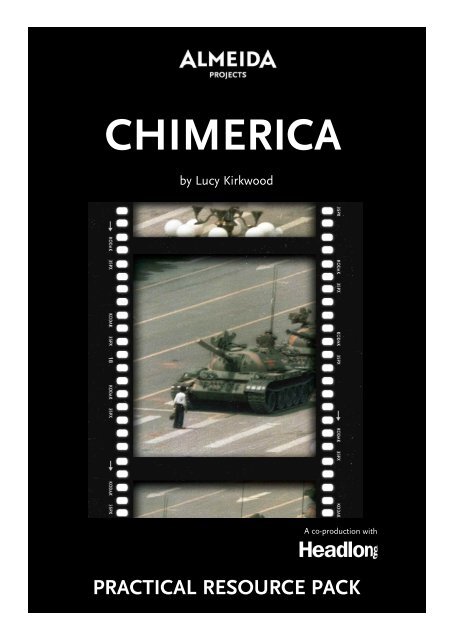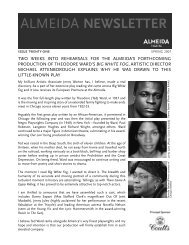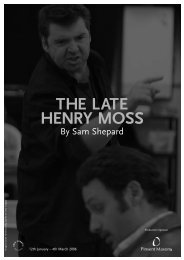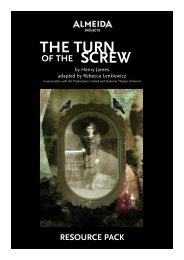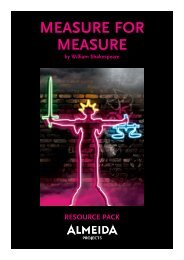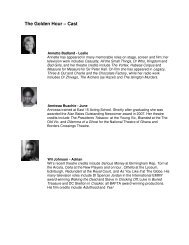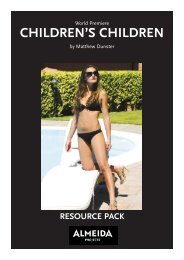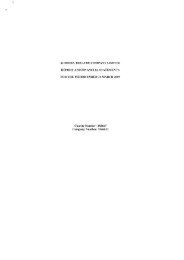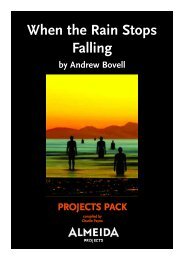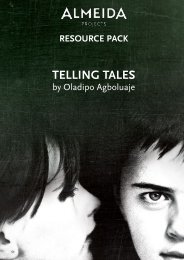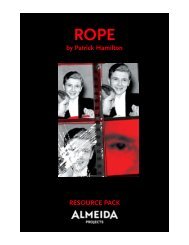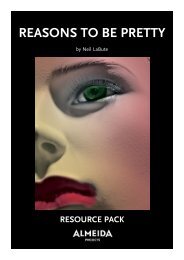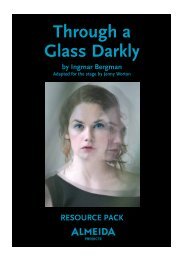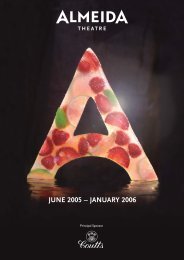Chimerica Resource Pack - Headlong Theatre
Chimerica Resource Pack - Headlong Theatre
Chimerica Resource Pack - Headlong Theatre
- No tags were found...
You also want an ePaper? Increase the reach of your titles
YUMPU automatically turns print PDFs into web optimized ePapers that Google loves.
CHIMERICAby Lucy KirkwoodA co-production withPRACTICAL RESOURCE PACK
IntroductionStephen Cambell Moore, Photo Johan Persson“I’ve spent a lotof time lately,apologizing. Forthings I’ve done.Not done. ThingsI’ve asked ofother people.”Joe, Scene 5.4Welcome to the Almeida <strong>Theatre</strong>’sproduction of <strong>Chimerica</strong>.Tiananmen Square, 1989. As tanks roll throughBeijing and soldiers hammer on his hotel door, Joe – ayoung American photojournalist – captures a piece ofhistory.New York, 2012. Joe is covering a presidentialelection, marred by debate over cheap labour and theoutsourcing of American jobs to Chinese factories.When a cryptic message is left in a Beijing newspaper,Joe is driven to discover the truth behind the unknownhero he captured on film. Who was he? Whathappened to him? And could he still be alive?Writer Lucy Kirkwood NSFW (Royal Court), It FeltEmpty When The Heart Went At First But It Is AlrightNow (Clean Break at the Arcola) and director LyndseyTurner Philadelphia, Here I Come! (DonmarWarehouse), Posh (Royal Court and West End) maketheir Almeida debuts with <strong>Chimerica</strong>, a provocativenew play which examines the changing fortunes oftwo countries whose futures will come to define ourown.<strong>Headlong</strong> returns to the Almeida <strong>Theatre</strong> following2008's critically-acclaimed The Last Days of JudasIscariot. Led by award-winning Artistic Director RupertGoold, they are one of the UK's leading theatrecompanies. Recent work includes The Effect andEarthquakes in London at the National <strong>Theatre</strong>,DECADE at St Katharine Docks and the multi awardwinningENRON at the Royal Court, in the West Endand on Broadway.We look forward to welcoming you to the Almeida<strong>Theatre</strong> and hope that <strong>Chimerica</strong> will entertain andinspire you and your pupils to further experience thepower of live theatre.For more information about Almeida Projects and our recent work visitalmeida.co.uk/education<strong>Resource</strong> <strong>Pack</strong>: <strong>Chimerica</strong>1
HOW TO USE THIS RESOURCE PACKUnlike our usual Almeida Projects <strong>Resource</strong><strong>Pack</strong>s, this one focuses specifically on how youmight continue to explore and develop the playthrough practical activities in the classroom. Itis a practical exercise pack rather than a studyguide.For contextual information about the play, seethe <strong>Chimerica</strong> programme or visitalmeida.co.uk/chimerica/moreheadlong.co.uk/work/chimericaLEARNING AREASThis Practical <strong>Resource</strong> <strong>Pack</strong> is designed toprovide drama-based exercises for you to usein the classroom. It is not curriculum-specificbut may be suited to the following work areas:• English Language and Literature• Drama or <strong>Theatre</strong> Studies• PSHE and Citizenship• Media StudiesContentsContents<strong>Chimerica</strong> Practical <strong>Resource</strong> <strong>Pack</strong>Production Credits 3Practical ExercisesHeroes 4Interpreting scenes - tableaux & monologues 5Diary entries and monologues 7Photography 9Debate: Ethical Journalism 9Translation/Mistranslation/Understanding 11Censorship and Surveillance 12Protest 14Copies of this <strong>Resource</strong> <strong>Pack</strong> can be downloaded free as a PDF file fromalmeida.co.uk/resourcepacks<strong>Resource</strong> <strong>Pack</strong>: <strong>Chimerica</strong>2
Production Credits20 May – 6 July 2013CHIMERICAby Lucy Kirkwooda co-production with <strong>Headlong</strong>Cast in alphabetical order:Tessa KendrickClaudie BlakleyProduction Team:Production ManagerJoe SchofieldStephen Campbell Moore Deputy Production ManagerLiuli/JenniferElizabeth Chan Company Stage ManagerMichelle/Mary Chang/Deng Vera ChokDeputy Stage ManagerDavid Barker/Peter Rourke/Paul Kramer/Officer Hyte Karl CollinsAssistant Stage ManagerCostume SupervisorFrank/Herb/Drug Dealer Trevor CooperCostume AssistantSusannah Schofield/Martha/Doreen/Maria Dubiecki Nancy CraneWardrobe SupervisorDeputy Wardrobe SupervisorMel StanwyckSean GilderWigs and Make-Up byFeng Meihui/Ming Xiaoli Sarah LamWigs and Make-Up SupervisorYoung Zhang Lin/Benny Andrew LeungDresserZhang Wei/Wang Pengsi David K.S. TseUniforms byZhang LinBenedict Wong Chief TechnicianAll other parts played by the companyLighting TechnicianSound TechnicianCreatives:DirectorLyndsey TurnerAssistant <strong>Theatre</strong> TechnicianStage CrewSet DesignEs DevlinLightingTim LutkinSoundCarolyn Downing Production CarpenterVideoFinn RossSet built byCostume DesignChristina Cunningham Set painted byCastingJulia Horan CDG Wardrobe work placementDialect CoachMichaela Kennen TRH Masterclass StageMandarin CoachBobby XinyueManagement ApprenticeMovementGeorgina Lamb Production and rehearsalFight DirectorBret Yountphotos byJames CroutAggi AgostinoMaris SharpCharlotte PadghamKatie BarrettEleanor DolanMiwa MitsuhashiEleanor DolanRachel WriterAnna MorenaFay LumsdaleKeshini RanasingheFlame TorbayJason WescombeRobin FisherHoward WoodTony ForresterBen CarmichaelSimon PerkinsRobert WeatherheadGruff CarroMiraculous EngineeringKerry JarrettKate SibleyEleanor ButcherJohan PerssonAlmeida <strong>Theatre</strong>Artistic DirectorExecutive DirectorArtistic AssociateArtistic Associate(Maternity Cover)Almeida ProjectsCo-Director of ProjectsCo-Director of ProjectsCommunity andParticipation ManagerSchools andEducation ManagerProjects AdministratorRupert GooldJulia PottsJenny WortonLucy MorrisonSamantha LaneEJ TrivettBoris WitzenfeldCharlie PayneSarah Tarry<strong>Resource</strong> <strong>Pack</strong>: <strong>Chimerica</strong>3
Playwright Lucy Kirkwood used the iconic photograph of the ‘Tank Man’ in Tiananmen Square asinspiration for her play <strong>Chimerica</strong>. This image was captured by a number of photographers, fromnumerous angles, with American photojournalist Jeff Widener’s shot being one of the mostfamous. The following practical exercises use the play, <strong>Chimerica</strong>, and photography as a startingpoint for discussion, debate and drama in the classroom.Exercise 1. HeroesOne of the key themes within <strong>Chimerica</strong> is the notion of what defines a hero or heroic act? The play is centredon a photograph of the Tank Man in Tiananmen Square, who stands up to the police and physically placeshimself, as a target, in front of the tanks. He knows that this means that he might be killed, but he believes sopassionately in his cause that he does it anyway.In the following practical drama exercise the class will explore different notions of heroism and what it means tothem.a. Start by dividing your class into goups of three. In these groups ask them to discuss whatheroism means to them.b. Ask them to think of particular situations, imaginary or real, in which someone acts heroically.It can be a very small act or something much bigger. In their groups ask them to decideupon two acts of heroism.c. Now ask them to think about other people in these scenarios. Would all of the people involvedconsider the act heroic? Ask them to think about a character from each senerio who would notconsider the act heroic and a reason why that might be.d. Ask the group to decide which act they like the best; it could be one or a mixture of both.e. Once all of the decisions have been made, ask the group to devise a short scene based on theheroic scenario they have chosen. Rehearse and show back the pieces. Discuss after eachpiece with the group:• What characteristics help you identify the hero in the piece?• What was the heroic act?• Would everyone think that what the hero did was heroic? If not, why not?Practical ExercisesElizabeth Chan and Andrew Leung, Photo Johan Persson<strong>Resource</strong> <strong>Pack</strong>: <strong>Chimerica</strong> 4
Practical ExercisesExercise 2. Interpreting scenes using tableaux and photographsThere are three approaches to this exercise; the first part is an extension of the second, the thirdprovides further extension into creating characters and devising a performance. You might find thepreliminary exercise useful to link to existing study or curriculum topic:Part 1a. Ask the class to each select an image from a book, newspaper, magazine, online with morethan three people in the ‘scene’.b. Consider the different images sources and how the tone of the picture changes from anewspaper to a magazine, from journalism to entertainment. Discuss the differences.c. Next, divide your class into small groups of 3-5 people.d. Each group must now choose one of the images to work with as a group and nominatethemselves to represent each character in the scene.Part 2 - Developmenta. Either using the image above as a starting point or by creating a tableau, a frozen image, ofyour own choosing, ask the group to stand up and form the scene from their image.b. Consider the details of each character in the image: How are they standing? What are theydoing? What is their role in this image? Are the powerful or lowly (high or low status)?c. Next, ask the group one at a time to create a headline, or a title, for the image. What do theythink is going on? And what does this headline tell the audience?d. Discuss as a group how each person interprets the scene differently. How did theinterpretations change? Which did they like the most? What makes it more interesting?Part 3 - Extensiona. Now encourage the group to bring their scenes to life, improvising the outcomes of thesescenes. Try to limit the scenes to just 1 minute at first, to really challenge the group to tell thecore of the story concisely.b. If you have the time, you might want to use the character questionnaire enclosed in this packto help you to create a backstory for each character, this will enrich the scenes.c. After 10 minutes, or less if you are short for time, each group should take it in turns to showtheir scene to the rest of the class.d. Finally, some constructive feedback from the class will help the group to develop their scenesfurther. If you have the time, why not use this scene as the starting point to devise aperformance? Would this be the opening or closing scene? What story can these characters telltogether?“What is this an image of? Protest, of course, butmore than that, this is a picture of the momentthat China exchanged democracy for an economicmiracle. For the opportunity to work, live, spend,progress.”Tess, Scene 4.7<strong>Resource</strong> <strong>Pack</strong>: <strong>Chimerica</strong> 5
CHARACTER QUESTIONNAIRE1. Where does your character live?2. Who does your character live with?3. Where is your character from?4. How old is your character?5. Which time period is your character from?6. What is your character called (think abouttheir real name and a nickname if it is different)?7. What does your character look like?8. How does your character stand, walk, sit?9. Who else is in your character's life?10. What kind of childhood did he or she have?11. What does your character do for a living?12. What is your character’s role in theircommunity (do they have power or status)?13. How does your character deal with conflict andchange?14. What is your character most afraid of?15. What is your character's goal or motivation inthis story or scene?“A man goesout to buy apaper, or anew shirt orsomething,and by the endof the day, he’spart ofhistory.”Tess, Scene 2.4Practical ExercisesBenedict Wong, Photo Johan Persson<strong>Resource</strong> <strong>Pack</strong>: <strong>Chimerica</strong>6
Practical ExercisesExercise 3. Diary Entries and MonologuesIn the play there is some confusion about an advert that was placed in a Chinese newspaper whichread “To Wang Pengfei. The Unknown Hero of the Square”. The following extract from Scene 4.9highlights the two different interpretations of this advert. Joe thinks that the ‘hero’ is the man in frontof the tank, but Pengsi tells us that the ‘hero’ is the man inside the tank.Part 1a. Read the extract below, either in pairs or aloud as a group.b. Write a diary entry for each of the ‘heroes’ talking about how they felt in that moment; oneinside the tank, the other in front of the tank. This piece works well as a homework exercise tothen be developed in the classroom using the development activity in Part 2.PengsiJoeJOE shakes him again.PengsiJoePengsiPlease. My brother was…Your brother was what?Your brother was what?Yes.Yes what? The Tank Man?Yes. Tank Man.Pause. JOE releases PENGSI. Stumbles away. Holds his fist.JoeIs he… is he okay? Is Wang Pengfei alive?PENGSI shakes his head, JOE shows him the Tank Man photo again.Joe Are you sure? Look. This man, you’re sure he’s not –PengsiJoePengsiI don’t know about this man.But you just said, he’s your brother.No, not my brother this man.Joe But you just / said –PengsiJoePengsiJoePengsiNot my brother, this man.You’re not making sense!The man…the tank…(points) This man.No. (he moves JOE’s finger) This man. Here. The soldier. Inthe tank, he was my brother. Unknown hero, my brother.<strong>Resource</strong> <strong>Pack</strong>: <strong>Chimerica</strong>7
Practical ExercisesExercise 4. Photography<strong>Chimerica</strong> is a story constructed around an iconic image. We are surrounded by imagery every day innewspapers, magazine, online and on billboards. This exercise puts you in the role of Joe thephotojournalist in the play; he snapped a chance image from his hotel window which went on tobecome one of the most famous photographs in the world.Part 1a. Take a photo with a digital camera or mobile phone from out of a window. Don’t think toomuch about composing a perfect photograph, as Joe in the play would not have had time toset up his shot. Simply take a snap based on the first thing that you see.b. This exercise could be repeated at hourly intervals over the course of the day, daily over thecourse of a week, or once a month for a year. Why not take your photo from the same windoweach time? How does the world outside change from photograph to photograph?Part 2 - Developmenta. Select either a single image, or a set, from your collection.b. Next think about what is happening in the photo. Who are the people? What are they doing? Isthere any drama: tension or conflict? What makes it interesting? How else might we interpretthis scene?c. Discuss the various images as a group.Part 3 - Extensiona. Using the photo as a starting point, ask the group to write a short narrative based on thescene in the image.b. Discuss whether the piece should be written in prose or as a script? Which other formatswould work for this narrative? Within the group explore the merits of each writing style: apoem, a duologue, a monologue, a story.QUICK HOMEWORK IDEADon’t have much time? Why not snap your photograph using your mobile phone and tweet yourpicture along with a 140 character micro-story to @AlmeidaProjects using #<strong>Chimerica</strong>Exercise 5. Debate: Ethical JournalismThis exercise best suits the PSHE, Citizenship, English and Media Studies curriculum.Journalism in Ethics are regularly under the microscope in today’s media, with high profile casesunder the spotlight.Part 1Start as a class by discussing the following terms and cases to ensure understanding. Detailedresearch into these topics might be set as homework:• Leveson Enquiry• Phone Hacking Scandal• Celebrity Super-injunctions• 1997 Sun Newspaper Labour Election Victory• Millie Dowler Case• Wikileaks• Citizen Journalism<strong>Resource</strong> <strong>Pack</strong>: <strong>Chimerica</strong>9
Practical ExercisesExercise 6. Translation/Mistranslation/UnderstandingSometimes it is difficult to translate easily from one language to another as the words get lost intranslation – and when taken literally can distort the meaning. This is evident in the play when Bennyvisits Joe’s exhibition and asks Joe how much one of his photographs costs:BennyJoeBennyJoeYeah so great picture, dude. Like. Immense. So how much?The gallery price them. I think that one’s about eight thousand dollars.Okay, and is there any room for movement on that?Sure. I could charge you nine thousand dollars.,Benny Look, dude, I never bought art before, I / don’t know –JoeI’m sorry. That was. So you’re studying at Harvard, right?Benny is confused by Joe’s words, he does not detect the sarcasm. Realising this, Joe changes thesubject. Ask your students if they know of any phrases in other languages that, when translated literallyinto English, becomes distorted.This following is great for team dynamics and is a fun way of illustrating how difficult it is tocommunicate when language is a barrier – and how easily things can be lost in translation.a. Divide the class into equal groups of 4 or 5. Ask each group to invent a new country. Thepeople of this country need a way of communicating with each other – how do they say hello?How do they say goodbye? Is there a gesture that accompanies the greeting? And how do theysay yes and/or no?b. Once you have agreed on some basic methods of communication, ask one member of eachgroup to leave their group and go to a new one. The new member can only use their country’smethod of communication – as can the host group. How do you communicate with this newperson and make yourself understood? How does entering this new country, as an outsider,make you feel? Did using non-verbal communication help?“Zhang Lin, what’s thisword you keep using, thatone, there? And there, youbetter not be mentioningme, what does that mean?”Wei, Scene 3.7David K.S. Tse, Photo Johan Persson<strong>Resource</strong> <strong>Pack</strong>: <strong>Chimerica</strong> 11
“You think an emaillike that from anAmerican journalistdoes not get seenby the censors?‘Tank Man’, in thesubject line Joe, inthe subject line, areyou stupid orsomething?”Lin, Scene 2.7Exercise 7. Censorship and SurveillanceBenedict Wong, Photo Johan PerssonIn the UK, as a democratic country, we take our rights to freedom of speech for granted. However, inChina there are no such individual rights, and speech, books, music, films, the arts, the press, radio,television and the Internet can be, and often are, censored by the governement, the Communist Partyof China, if they contain objectionable, harmful, sensitive, or inconvenient communication.Practical ExercisesNotable censored subjects in China include, but are not limited to, democracy, the Tiananmen Squareprotests of 1989, Maoism, Falun Gong, ethnic independence movements, corruption, police brutality,anarchism, gossip, disparity of wealth, food safety, pornography, news sources that report on theseissues, religious content, and many websites.<strong>Chimerica</strong> deals with the ideas of censorship and surveillance throughout, particularly in the recordingof the history of Tiananmen Square. The event of the massacre, as well as the picture of Tank Man, arewell documented in the West, and many people know the history of that event. However in China, thisis not talked about, and certainly not taught in schools.Particularly pertinent in the play – and currently – is Internet censorship and surveillance. In China,Internet censorship and surveillance are used as a means of controlling what people find out, andgovernment surveillance of the Internet means that even attempts to search for certain things couldflag you up to the authorities, meaning you are watched even when in your own home.In the play, Lin’s article is only online for six hours before it is firewalled. The following exercise,entitled Paranoia, aims to engage participants in what it feels like to be watched by many people atone time, and the effect of surveillance on your behaviour.<strong>Resource</strong> <strong>Pack</strong>: <strong>Chimerica</strong>12
Exercise 7. ProtestThe Tiananmen Square protests were triggered in April 1989 by the death of former Communist PartyGeneral Secretary, Hu Yaobang, a liberal reformer, who was removed from power after losing a hisbattle with hardliners over the direction of Chinese economic and political reforms. University studentswho marched and gathered in Tiananmen Square to mourn Hu also voiced grievances againstinflation, limited career prospects, and corruption within the party. They called for governmentaccountability, freedom of the press, freedom of speech, and the restoration of workers' control overindustry. At the height of the protests, about a million people assembled in the Square.In <strong>Chimerica</strong>, Lin writes a blog entry about the pollution levels in the atmosphere, posting what heperceives as the real levels rather than the party’s skewed results. In doing so, he knows that he will bereprimanded – but he feels so strongly about it that he is willing to take the repercussions.In the UK, it is difficult for us to imagine what it must be like to not be allowed to speak your mind –or to be reprimanded for doing so. The following exercise aims to give students some idea of what thismight feel like.Part 1Ask a volunteer to talk about a subject they feel passionatly about. Once they have decided on thesubject, have the group brainstorm words associated with that subject. Pick your top five and writethem on the wall. Now ask the volunteer student to talk for two minutes on their subject without usingany of the listed words. If they do, the other students must sound a buzzer or shout ‘CENSORED.’How did that feel for the volunteer? What was it like to not be able to speak freely? What did it makehim/her want to do?Part 2 - ExtensionYou could extend this exercise by creating a physical representation of protest. Place a chair at one endof the room. Have the group decide what the protest is about. The chair now represents this. Ask for avolunteer. The aim for this person is to reach the chair, stand on it, and shout aloud what they areprotesting about. Now ask the other students (the censors) to create different obstacles to physicallystop that person from getting to their destination. No touch allowed. Does the person succeed? Whattactics did they use? How did they find this? How did they feel if/when they were eventually heard?Remind the students that protest doesn’t have to be in the form of marches – in the play Lin uses thepower of writing and the medium of the Internet to share his views.Practical ExercisesPart 3 - Further ExtensionThe quote below is from his article. As an extension, you could have students write an article on asubject that they feel passionatly about.“Somewhere in Beijing tonight, a woman dies athird-world death in a new world China built on hersweat, and her blood, and her sacrifice. And acrossthe city, an official scratches his belly in his sleep,and dreams of regulations.”Lin’s article Scene 4.2<strong>Resource</strong> <strong>Pack</strong>: <strong>Chimerica</strong>14
Photo Ludovic des Cognets<strong>Chimerica</strong>Almeida Projects <strong>Resource</strong> <strong>Pack</strong>Compiled by EJ Trivett withcontributions from Samantha Lane,Charlie Payne, Sarah Tarry and BorisWitzenfeld.<strong>Chimerica</strong> by Lucy Kirkwood wasproduced at the Almeida <strong>Theatre</strong> 20May - 6 July 2013.The information in this <strong>Resource</strong> <strong>Pack</strong>is correct at the time of going to press.All rights reserved. © Almeida<strong>Theatre</strong>, Published May 2013.The Almeida <strong>Theatre</strong> is a RegisteredCharity No. 282167. The Almeida<strong>Theatre</strong> Company Limited, AlmeidaStreet, London N1 1TA. Use of thisAlmeida Projects <strong>Resource</strong> <strong>Pack</strong> isauthorised in connection with theAlmeida Projects work at the Almeida<strong>Theatre</strong>. Any further use in any formmust be approved by the creators. Thecopyright of all original materialremains with the creators.Almeida Projects is the Almeida <strong>Theatre</strong>’screative learning programme.Since 2002 our main aim has been to inspire the theatre-makers, theatregoersand theatre-lovers of the future. Each year we provide more than10,000 opportunities for young people to participate in projects led byexperienced industry professionals inspired by main-stage shows in ourproducing theatre.Our Schools and Education programme is really important to us, which iswhy we have a number of ways that we can work together with you.Depending on your needs, budget and the time you have available, we workwith the education sector in the following ways:Subsidised TicketsA comprehensive package of discounted theatre tickets, in-school workshopsand a personal host for the production to answer any questions about thetheatre or the show.Residencies and Workshop <strong>Pack</strong>agesWe offer packages to bring the expertise of our practitioners in your schoolfrom one-off workshops to year-long residencies, all tailored in response toyour students’ academic needs. From backstage tours and careers talks todevising and character masterclasses, we use our resources as a world-classproducing theatre to deliver quality work to enrich students’ experience.For more information about our work, please visit our website:almeida.co.uk/educationAlmeida Projects is supported by:AnonymousAspenBank of America Merrill LynchCharles Skey Charitable TrustChapman Charitable TrustSimon and Caroline ClarkElm Capital Associates LtdThe Worshipful Company of GrocersIslington CouncilThe Lehman Brothers Foundation EuropeThe Mildred Duveen Charitable TrustMishcon de ReyaThe Noël Coward FoundationThe Ormonde & Mildred Duveen TrustPinsent MasonsThe Rayne Foundation


